Archived Fire Damage Blog Posts
The importance of fire drills in schools and public buildings
8/14/2024 (Permalink)
 At SERVPRO, we are committed to promoting safety and preparedness in all environments.
At SERVPRO, we are committed to promoting safety and preparedness in all environments.
At SERVPRO®, we understand that safety is a top priority for schools and public buildings. One of the most effective ways to ensure safety in these environments is through regular fire drills. Fire drills are crucial in preparing individuals for emergency situations, minimizing potential chaos, and ensuring a smooth evacuation process.
Why Fire Drills Matter
Fire drills are not just procedural formalities; they are essential practices that can save lives. In schools, they help students, teachers, and staff familiarize themselves with the evacuation routes and protocols. For public buildings, fire drills ensure that employees and visitors know how to respond promptly and correctly in case of a fire.
Benefits of Regular Fire Drills
Preparation and Awareness:
Regular fire drills ensure that everyone in the building knows the sound of the alarm, the nearest exits, and the quickest evacuation routes. This preparation is vital in reducing panic and confusion during an actual emergency.
Role Reinforcement:
Fire drills help reinforce the roles and responsibilities of fire wardens and safety officers. These individuals play a critical role in ensuring everyone evacuates safely and efficiently. Regular practice helps them maintain readiness and confidence in their duties.
Identifying and Addressing Issues:
Fire drills can reveal potential problems in the evacuation plan, such as blocked exits or malfunctioning alarms. Identifying these issues during a drill allows for corrective action before an actual emergency occurs, enhancing overall safety.
Compliance with Regulations:
Many local and state regulations require regular fire drills in schools and public buildings. Conducting these drills ensures compliance with safety standards and avoids potential fines or legal issues.
Implementing Effective Fire Drills
To maximize the effectiveness of fire drills, it’s important to follow a structured approach:
Develop a Clear Plan:
Ensure that there is a detailed evacuation plan in place. This plan should include primary and secondary exits, designated assembly points, and roles and responsibilities for staff members.
Communicate with All Parties:
Inform everyone in the building about the fire drill schedule and procedures. Clear communication helps reduce anxiety and ensures that everyone understands their role during the drill.
Simulate Realistic Scenarios:
Conduct drills at different times and under varying conditions to prepare for all possible scenarios. This variation helps ensure that occupants are prepared for an emergency, regardless of the situation.
Review and Improve:
After each drill, conduct a thorough review to identify any areas for improvement. Gather feedback from participants and make necessary adjustments to the evacuation plan.
Fire drills are a vital component of safety preparedness in schools and public buildings. They ensure that everyone knows how to respond in an emergency, help identify and rectify potential safety issues, and ensure compliance with safety regulations. At SERVPRO, we are committed to promoting safety and preparedness in all environments. Regular fire drills are a simple yet powerful tool to protect lives and property.
By prioritizing fire drills, you contribute to a safer environment for everyone. Stay prepared, stay safe.
Garage Fire Prevention: Keeping Your Space Safe and Secure
4/18/2024 (Permalink)
Your garage is more than just a place to park your car or store your tools; it's an integral part of your home. However, it's also a space where fires can occur if proper precautions aren't taken. Fortunately, there are several simple steps you can take to prevent garage fires and keep your space safe and secure.
Regular Maintenance and Inspection
One of the most effective ways to prevent garage fires is by conducting regular maintenance and inspections. Check your electrical wiring for signs of damage or wear, and replace any frayed cords or malfunctioning outlets. Keep your garage clean and clutter-free, as combustible materials such as old newspapers, cardboard boxes, and chemicals can easily fuel fires.
Proper Storage of Flammable Materials
If you store flammable materials such as gasoline, propane, or paint thinner in your garage, it's essential to store them properly. Keep these substances in tightly sealed containers and away from heat sources, sparks, or open flames. Consider storing them in a dedicated flammable storage cabinet for added safety.
Safe Use of Appliances and Tools
Be cautious when using appliances or power tools in your garage. Always follow the manufacturer's instructions and never leave them unattended while in use. Keep them away from flammable materials and ensure they are in good working condition to prevent electrical fires.
Install Heat Detectors and Fire Extinguishers
Install heat detectors in your garage and test them regularly to ensure they are working correctly. Additionally, keep a fire extinguisher in an easily accessible location and familiarize yourself with how to use it. In the event of a fire, early detection, and immediate action can make all the difference in minimizing damage and ensuring everyone's safety.
Educate Your Family
Finally, educate your family members about fire safety in the garage. Teach them about the dangers of flammable materials and the importance of proper storage and usage of appliances and tools. Develop and practice a fire escape plan so that everyone knows what to do in case of an emergency.
By following these simple tips, you can significantly reduce the risk of garage fires and protect your home and loved ones. Remember, fire prevention starts with awareness and proactive measures, so take the necessary steps to keep your garage safe and secure.
A Guide to Choosing a Reputable Fire Restoration Company
11/30/2023 (Permalink)
Experiencing a fire in your property can be overwhelming and stressful. During this difficult time, engaging a reputable and trustworthy fire restoration company is essential for restoring your property and regaining a sense of normalcy. However, selecting the right restoration company can be a daunting task. In this blog, we will guide you through the essential criteria to consider when choosing a fire restoration company, ensuring that you have the best possible support during the restoration process.
Certification and Accreditation
Look for a fire restoration company that is certified and accredited by industry associations, such as the Institute of Inspection, Cleaning, and Restoration Certification (IICRC) or the National Institute of Fire Restoration (NIFR). Certification indicates that the company adheres to industry standards, possesses up-to-date knowledge, and employs qualified technicians.
Experience
- Experience is critical when it comes to fire damage restoration. Look for a company with a proven track record of successfully handling fire damage restoration projects.
- A reputable company will have experience in handling various types of fires and damages, from minor smoke damage to significant structural damage.
Availability and Response Time
Fires can occur at any time. It is crucial to look for a company that offers 24/7 availability and emergency response. A prompt response time is essential in mitigating further damages and enhancing the chances of successful restoration.
Reputation and Reviews
Research the company's reputation and read reviews from past customers. Check their website, social media platforms, and online review sites to get a sense of their customer service, quality of work, and overall reputation.
Insurance and Licensing
Ensure that the restoration company is licensed by the relevant authorities and carries proper insurance coverage. Liability and workers' compensation insurance are crucial in protecting you from any potential damages or injuries that may occur during the restoration process.
Methodology and Equipment
A reputable fire restoration company will employ the latest restoration techniques and industry-grade equipment. Look for a company that uses advanced methodologies, such as the use of HEPA air filters, activated carbon filters, or thermal fogging, to effectively remove smoke residues and odors.
Customer Service
Excellent customer service is a critical element in ensuring a smooth and stress-free restoration process. Choose a company that communicates clearly and effectively, providing regular updates and answering any questions or concerns you may have.
Choosing a reputable fire restoration company is crucial in restoring your property and helping you move on from the trauma of a fire incident. By considering factors such as certification, experience, availability, reputation, insurance, methodology, and customer service, you can make an informed decision and engage a company that can deliver quality restoration services. It is best to do your research and reach out to multiple restoration companies to compare services, prices, and capacity before settling on one. With the right restoration company, you can effectively restore your property and move towards a safe and healthy living environment.
Some of the Most Common Ways Fire Starts
10/13/2022 (Permalink)
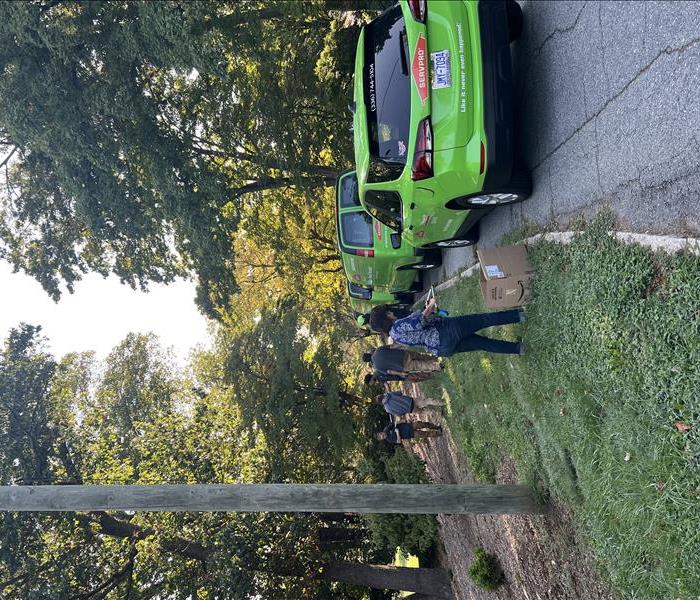 Some firefighters putting out a house fire
Some firefighters putting out a house fire
A fire alarm system from Circle City Security Systems could be the difference between life and death. A fire can be a devastating blow to any home or business. Knowing what you’re up against can help reduce the chance of a fire occurring significantly. Here are the top 8 most common fire starters.
Smoking Indoors
Smoking in a commercial building is illegal in almost every building in the United States. Many people, however, still smoke in their homes. People who have smoked for a long period of time typically begin to underestimate the power of one errant ash. You shouldn’t allow smoking in your home as it is not only a fire hazard but it is damaging to the structure.
Unmaintained Dryer Vents
Lint can quickly accumulate in dryer vents if they are not cleaned regularly. Lint burns extremely quickly and it only takes one spark or too much heat for the entire house to go up in flames. When installing dryer exhaust vents, avoid making the vent turn at 180 degree angles; that is a place for lint to easily accumulate.
Faulty Electrical Equipment
Your toaster from the 70’s may have sentimental value to you but perhaps you should just put it on display and buy a new one for toasting. Over worn cords and frayed electrical wires in electronics are a huge fire hazard.
Overloading Outlets
Another electrical hazard is overloading an outlet or extension cord. Never plug multiple power outlets into each other. A circuit breaker is a good protection from overloading but they do not guarantee safety from an electric fire from overload.
Candles
Candles look and smell great and can make your house feel like home. Unfortunately they can also make your house into an inferno. You shouldn’t ever leave the house with candles burning. Also make sure all candles are on a sturdy surface or holder that can’t fall over or be knocked over by a child or pet.
Speaking of children, they’re pyromaniacs!
It is important to talk to your children about the dangers of playing with fire. A large percentage of fires started are from children playing with it. Don’t leave matches or lighters laying around for a child to find and make sure they know they’re off limits.
Space Heaters
Space heaters or heat dishes are a great tool to help get warmth to unventilated parts of the house or the garage or shed. They do have the potential to be very dangerous, however. Nothing should be left to close in front or back of a space heater. The unit itself can get very hot, not to mention the air it disperses.
Cooking
Perhaps the biggest cause of fires is careless cooking habits. You should always be attentive to your food especially when hot oil is involved. Open flame stoves are especially dangerous. Always keep a fire extinguisher in the kitchen.
Smoke Can Effect Your Business
10/10/2022 (Permalink)
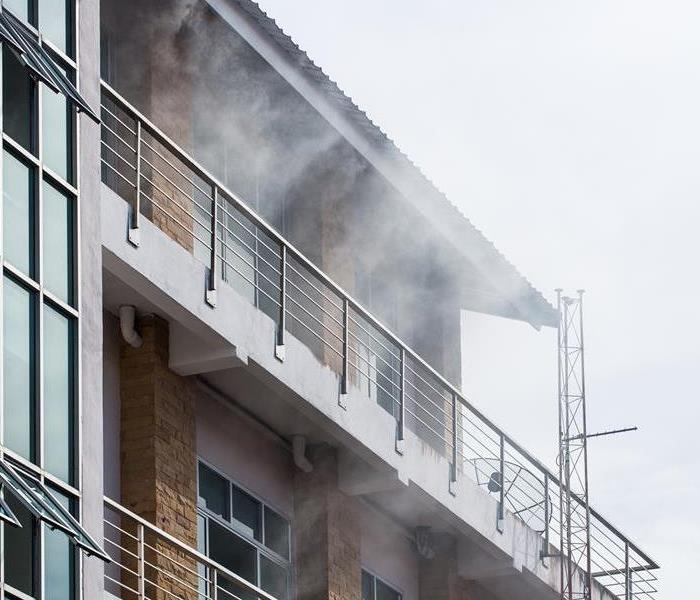 Smoke coming out of apartment windows
Smoke coming out of apartment windows
Restoring your business after fire damage to its pre-fire condition is our main goal. As a leading fire damage restoration company, we specialize in fire damage cleanup and fire restoration, smoke damage cleanup, and removal of smoke odors. Our team will deep-clean and remove soot from walls, carpets, and upholstery. Beyond the fire damage, smoke and soot can be toxic, creating a hazardous situation. Even if a fire is contained in one area, smoke and soot can travel throughout a structure. Our professionals are highly-trained, with the experience, tools, and knowledge to clean up fire damage and remove the smell of smoke. In keeping with our goal to restore your home and cherished possessions to their pre-fire condition, we use appropriate personal protective measures to safely clean, deodorize and restore your property. As a business owner, you know that any disruption in business affects your bottom line. We have large loss teams that work alongside our local SERVPRO experts. These restoration professionals can respond quickly and understand your unique set of problems when faced with fire damage cleanup and smoke damage removal. Our goal is to help you get your business up and running again as soon as possible after a fire.
How Smoke from Fires Can Affect Your Health
9/13/2022 (Permalink)
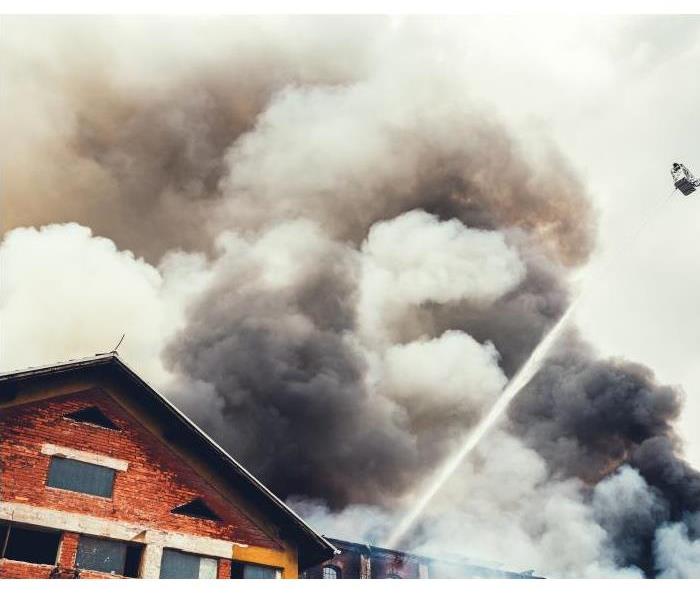 Smoke coming from the roof of the house
Smoke coming from the roof of the house
Smoke may smell good, but it's not good for you. While not everyone has the same sensitivity to wildfire smoke, it’s still a good idea to avoid breathing smoke if you can help it. And when smoke is heavy, such as can occur in close proximity to a wildfire, it’s bad for everyone. Smoke is made up of a complex mixture of gases and fine particles produced when wood and other organic materials burn. The biggest health threat from smoke is from fine particles. These microscopic particles can penetrate deep into your lungs. They can cause a range of health problems, from burning eyes and a runny nose to aggravated chronic heart and lung diseases. Exposure to particle pollution is even linked to premature death.
Some people are more at risk
It’s especially important for you to pay attention to local air quality reports during a fire if you are
a person with heart or lung disease, such as heart failure, angina, ischemic heart disease, chronic obstructive pulmonary disease, emphysema, or asthma.
an older adult, which makes you more likely to have heart or lung disease than younger people.
caring for children, including teenagers, because their respiratory systems are still developing, they breathe more air (and air pollution) per pound of body weight than adults, they’re more likely to be active outdoors, and they’re more likely to have asthma.
a person with diabetes, because you are more likely to have underlying cardiovascular disease.
a pregnant woman, because there could be potential health effects for both you and the developing fetus.
How to tell if smoke is affecting you
High concentrations of smoke can trigger a range of symptoms.
Anyone may experience burning eyes, a runny nose, cough, phlegm, wheezing, and difficulty breathing.
If you have heart or lung disease, smoke may make your symptoms worse.
People with heart disease might experience chest pain, palpitations, shortness of breath, or fatigue.
People with lung disease may not be able to breathe as deeply or as vigorously as usual and may experience symptoms such as coughing, phlegm, chest discomfort, wheezing, and shortness of breath.
Protect yourself! It’s important to limit your exposure to smoke - especially if you are at increased risk for particle-related effects. Here are some steps you can take to protect your health: If you have heart, vascular, or lung disease, including asthma, talk with your health care provider. Prepare for fire season if you live in a fire-prone area. If you have heart, vascular, or lung disease, including asthma,talk with your health care provider before fire season to make plans. Discuss when to leave the area, how much medicine to have on hand, and your asthma action plan if you have asthma. Have a several-day supply of nonperishable foods that do not require cooking. Cooking - especially frying and broiling - can add to indoor pollution levels.
Call SERVPRO to put an air cleaner in your home. Air cleaners can help reduce particle levels indoors. They will make the house smell brand new.
Are You Safe to Stay in Your House After a Fire?
9/7/2022 (Permalink)
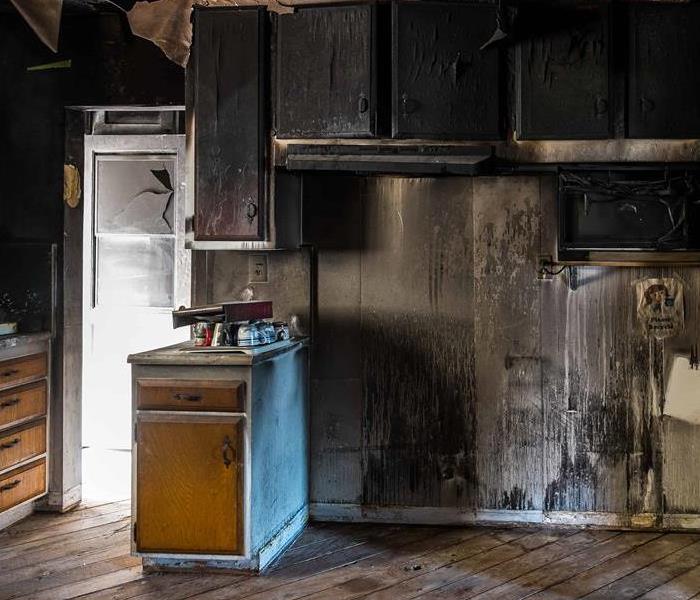 Photo is a kitchen that was damage by a fire
Photo is a kitchen that was damage by a fire
No, it is not safe to stay in your home after a fire. You need to have the area inspected, cleaned, and repaired first. Even a small house can release toxic chemicals into the air which could hurt you and your family. The only way to be sure it is safe and not a health risk is to have an inspection done. Homeowners should immediately call their insurance company to report the fire, smoke, and soot damage. Then, contact SERVPRO to assist you with the cleanup and repair.
Specific health risks after a house fire include:
Structural damage – if the fire has compromised your home’s structural integrity the roof, walls, or floor could be at risk of caving in. You may need to install roof tarping or board-up holes in your walls in order to shield your home from the elements.
Toxic fumes – Breathing in carbon monoxide, soot, and smoke can cause irritation and possible long-term damage to your lungs.
Chemical residue – When plastic, wallpaper, paint, and other household items burn they release toxic chemicals into the air. These chemicals can settle into any nearby fabric, carpet, or other surfaces. If you touch them this residue will then be on your skin and in your clothing. It is best to have an IIRC-certified home renovation inspector evaluate your house before returning.
Even if the fire was very small it is still dangerous to sleep in your house right after a fire. The air is contaminated with smoke, soot, burned chemicals, toxic fumes, and everything else that was released into the air from the fire. These toxic particles spread throughout your home and get trapped in fabric, bedding, clothing, drapes, and carpet. Even after a small fire, you should immediately open your windows and doors to air out the house. Then, wait for your home restoration team to evaluate and repair the fire damage before you continue to sleep in your house.
Even if all you saw was smoke rather than flames, it may still be unsafe to sleep in your house. Instead of taking chances with your lungs, go ahead and have the inspection done. If you’ve filed a claim with your insurance company, it is possible they will cover the cost of the inspection. If it is necessary for you to sleep somewhere else while your property is being restored, your insurance plan should cover the cost of temporary lodgings. Contact your insurance agent to see what your individual plan covers.
The fire department will give you an “all clear” to allow you back into your house to recover your valuables after a fire. They will be checking to ensure that all flames have been extinguished and your home is still structurally sound. Once that occurs you can enter to retrieve valuables but should avoid spending large amounts of time inside until your home has been completely cleaned and restored.
Your belongings may have soot and smoke damage and may need to have fire damage restoration before they are safe to use again. You may need to take them to a safe location until they can be properly cleaned and sanitized by SERVPRO.
SERVPRO offers 24/7 emergency services in the event of a fire. We will collaborate with you and your insurance company to evaluate, clean, and restore your property after a fire. Schedule a free scope. We are here to help.
Why do Grill Fires Happen?
8/8/2022 (Permalink)
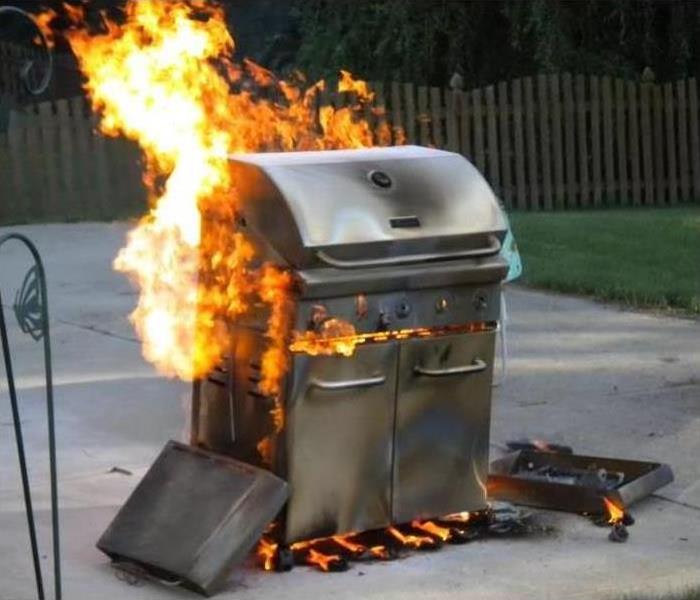 A grill has combusted and is burning out of control
A grill has combusted and is burning out of control
Why Your Gas Grill Keeps Catching on Fire
Gas grills are designed to produce a flame, so you may think it is always on fire. While it is technically accurate that you have a fire going, it is a controlled fire, and only the gas that is being supplied as the fuel is burning.
When referring to a gas grill catching on fire, it is a fire that is no longer controlled by the design of the grill.
Grease Buildup on Grill Surfaces
With repeated use of your grill, grease builds up on the grill’s surfaces. This grease comes from the fat in the meats you are grilling. As the meat heats up, the fat melts and drips to the surfaces below. When the grill is turned off, the grease solidifies on your grill surfaces.
Over time, with sufficient grease buildup, the grease can liquify, subsequently vaporize, and be ignited by the flame in your grill resulting in a grease fire.
If you are grilling excessively fatty meats, the dripping may be sufficient to cause a small grease fire on its own. This is one of the reasons an operating grill should never be left unattended.
Grease Buildup in Drip Pan
The drip pan below your grill is easy to forget about. You can’t see it as well as you can see the inside of the firebox. And because it is out of sight, it is more likely to have unsafe amounts of grease accumulate there.
Depending on your grill’s design, if the grease in the drip pan catches on fire, it can be a more dangerous situation. This is because the drip pan is outside of the firebox, which can help contain a grease fire in most occurrences.
If you have a cabinet below your grill that contains the grease management system, your drip tray could overflow out of sight. And if the grease in the catch pan catches fire, it can spread to those other areas.
Other Reasons Gas Grill Fires
Grease fires are the most common reason for fires related to gas grills. While other causes are less common, they can be just as dangerous, if not more.
A mechanical issue, like a rusted-out burner, could lead to excessive gas flow resulting in a larger fire than the grill is designed for.
Having any combustible materials in or near the grill can also result in a fire from your gas grill. Make sure your grill isn’t near any structures or other materials that can catch fire.
Finally, the most severe gas grill fire can be the result of a gas leak. A leak can allow the flammable gases to accumulate, leading to a fireball or explosion when you light your grill.
Fire Damage is our specialty at SERVPRO of Winston-Salem North. Call us for any issues you may have!!
Fireplace Safety Tips as Fall Approaches
8/8/2022 (Permalink)
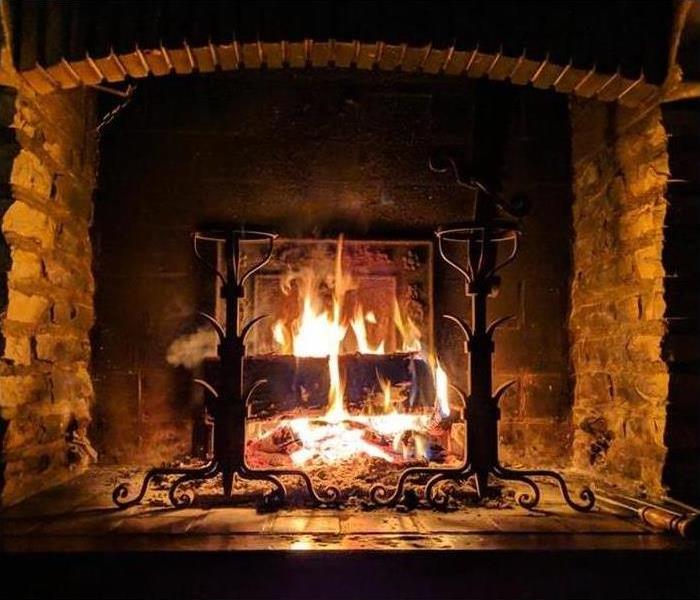 Fireplace Safety Tips
Fireplace Safety Tips
- Make sure the damper is open before lighting a fire so the fireplace will vent properly. Do not close your damper until you are sure the fire is out.
- When starting a fire, only use a match or commercial firelighter. Never use flammable liquids to start a fire.
- Keep fireplace glass doors open while burning a fire. This allows the fire to receive enough air for complete combustion and to help reduce creosote build-up in the chimney. Creosote is a substance that derives from incomplete combustion.3
- Keep metal mesh screens closed whenever your fireplace is in use to help keep embers in the fireplace.
- Only use dry wood in your fireplace. Wet wood can increase the build-up of creosote, which can lead to chimney fires. Select wood – preferably hard wood – that has been seasoned six months to a year.4
- Do not burn plastic: it can release toxic chemicals and cause damage to your chimney, fireplace or wood stove.
- Never burn a Christmas tree in your fireplace, as the sparks from burning needles can increase the risk for a chimney fire. Also, do not burn cardboard boxes, wrapping paper or trash in your fireplace.
- Never leave a fire in a fireplace unattended. Before leaving the house or going to bed, make certain to fully extinguish the fire.
- Allow ashes to cool completely before disposing of them and note that ashes can take several days to cool completely. Never empty ashes directly into a trash can. Instead, place ashes in a covered metal container located at least 10 feet away from your home and any other building.
Restoring Vs. Replacing
7/10/2022 (Permalink)
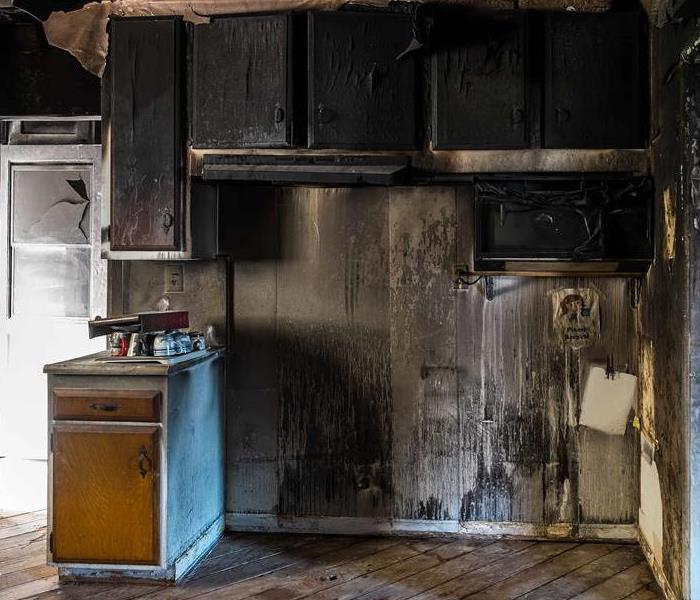 A kitchen has been mitigated to the point of repairs, now to decide what is repairable and what is replaceable.
A kitchen has been mitigated to the point of repairs, now to decide what is repairable and what is replaceable.
SERVPRO specializes in restoring your contents and property after a fire. Some things are irreplaceable, and we have the ability to salvage, clean and restore your items to like new condition. Our processes are tried and true. Not only, are we salvaging your original keepsakes and possessions, but we are saving you money in the process.
The kitchen in the picture has been mitigated and is ready for repairs and or restoration. While some of the structures will only require a little work to repair, some will also need to be replaced completely.
Fire Damage & How it effects Your Home
6/1/2022 (Permalink)
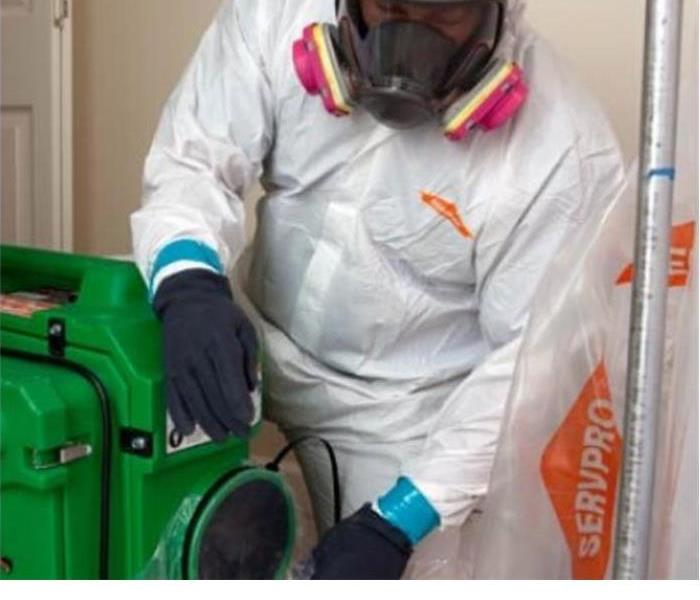 Remember SERVPRO in the event of a disaster!
Remember SERVPRO in the event of a disaster!
SERVPRO of Winston Salem North understands the devastation that occurs when a disaster such as a fire takes place in your home or business. We want our community to see how fire damage effects properties and is educated on how SERVPRO can help them.
Collapses: If structures in the home like support beams or the roof are affected this could cause more damage to the interior.
Odor: The longer fire damage sits in a home the worse it gets. The sooner you can get someone to mitigate the job the sooner the smell will improve.
Water Damage: Damaged piping or a damaged roof can create flooding.
In the Event of a Disaster remember SERVPRO of Winston Salem North!
The Effects of Water on a Grease Fire
5/6/2022 (Permalink)
The definition of a Grease Fire is "The type of fire resulting from cooking oil or any other flammable cooking or lubricating materials."
In the event of a grease fire:
- Turn off the heat, but do not try to move the pot from the stove as the grease could splash on you or the kitchen surfaces.
- Put a lid on the pot or frying pan to cut off oxygen to the fire.
- If the fire is out of control, the most important thing to do is to call 911 and get everyone outside.
- Do NOT pour water on a grease fire. Water can cause the grease to splash onto yourself or kitchen surfaces and spread the flames.
- Do NOT fan the fire with a dry or wet cloth. This can also cause the grease to splash or fire to spread onto other surfaces.
- Do NOT use flour on a grease fire. While sometimes baking soda can extinguish a small grease fire (though not if the fire is too overwhelming), flour cannot and should not be used.
- Due to chemical risk of contaminating your kitchen, putting out a grease fire with your fire extinguisher should be the last resort.
How to prevent a grease fire:
- Stay in the kitchen and keep an eye on the deep fryer or frying pan.
- Slowly heat the oil to your desired temperature.
- Turn off the burner if you suspect the grease is getting too hot.
- Place the food in the grease carefully to prevent hot grease splatter.
Q. What do you do after a grease fire occurs in you home?
A. Contact us at (336)744-5104
Why you should call SERVPRO of Winston Salem North for residential fire damage services
10/20/2021 (Permalink)
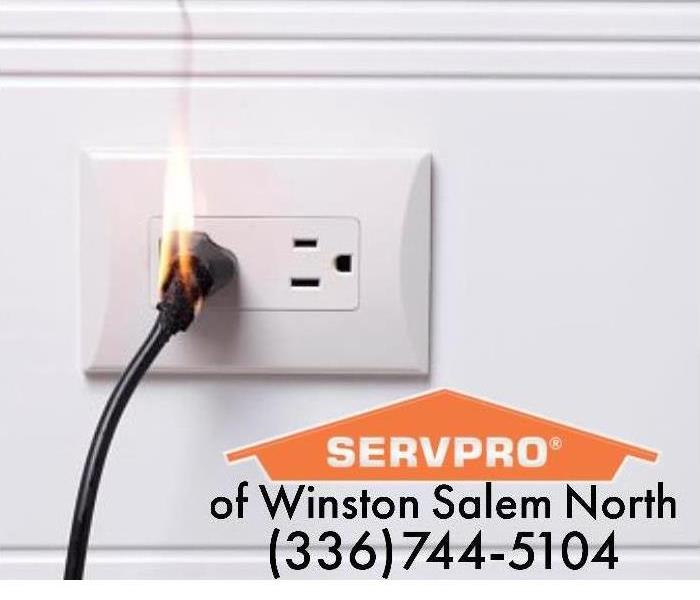 While we hope you never experience a disaster in your home, we do know we are ready to help you restore it in the event of one.
While we hope you never experience a disaster in your home, we do know we are ready to help you restore it in the event of one.
Call SERVPRO of Winston Salem North for Residential Fire Damage Services
When you need residential fire damage services, you should contact a locally owned and operated professional that can quickly diagnose the exact nature of your problem and then get right to work on solving it. Fire and smoke are particularly destructive forces that can gut a structure and cause it to be condemned. If your property is suffering from this sort of damage, you may need immediate help to salvage it.
You'll Need a Company That Specializes in Fire Damage Restoration:
After any damage has occurred, you should contact a company immediately for an initial diagnosis. This will then be followed by a team getting directly to work on cleaning up and fully restoring the affected area. Cleanup, removal of debris, neutralization of remaining odors, and purifying of the air can commence quickly to prevent any further health effects that often arise after fire damage.
Concentrate on Restoration Rather Than Replacement:
The focus of good restoration service should always fixate on restoring your property rather than replacing it. When possible, it's better to isolate quickly and neutralize any issues rather than replace your entire property. Restoration not only costs you less money in the long run, but it also allows you to quickly get back to living your life faster. If parts of the property do need to be completely rebuilt, talk to the company about timelines for the areas that are fixable first, and then concentrate on the areas that need to be entirely redone.
What to Expect From Any Service:
A reputable restoration service will do an immediate assessment of the damage, followed by board-up and tarp service if required. From there, they will remove all affected material and begin airing out and drying the general area. Once all of the debris, smoke, and soot have been eliminated from the area, they can begin restoring your property back to pristine condition.
What to Look For:
It's best to hire a locally owned company that has a focus and connection to your community. You should also ensure that the service personnel you are dealing with are fully qualified, trained, and experienced at diagnosing and solving the problems that affect your property. When you are dealing with severe fire and smoke damage, you want to make sure the company you choose can handle the scope of the project and will help you handle any problems that come up.
SERVPRO of Winston Salem North is a locally owned and operated authority for residential fire damage cleanup and restoration. When fire damage threatens properties in the areas of Winston Salem and the surrounding region, we can help. Contact us now for a prompt response to your fire damage emergency at (336) 744-5104.
Emergency Fire Damage Tips
9/14/2021 (Permalink)
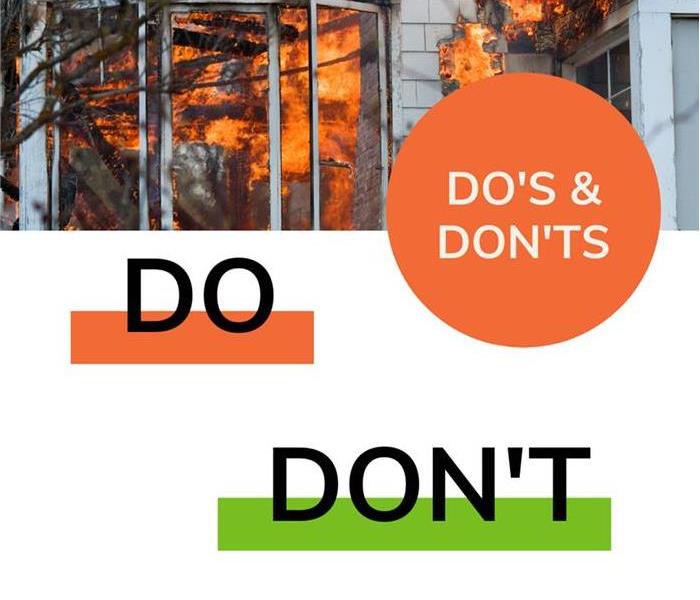 While we hope you never experience a disaster in your home or business, we do know we are ready to help you restore it in the event of one.
While we hope you never experience a disaster in your home or business, we do know we are ready to help you restore it in the event of one.
Did you know every 90 seconds a residential fire occurs somewhere in the U.S.? If a fire strikes your home or business, know that SERVPRO of Metairie is here to help
Until a SERVPRO professional arrives, here are some DO’s and DON’Ts to help reduce damage and increase the chances of a successful restoration:
DO:
- Limit movement in the home and keep your hands clean. This helps prevent soot particles from being embedded into your carpet or upholstery.
- Place old, dry colorfast towels or linens on rugs, upholstery, and carpet traffic areas.
- If electricity is off, empty the freezer and refrigerator completely and prop the doors open to help prevent odor.
- Wipe soot from chrome on kitchen and bathroom faucets, trim, and appliances. Protect the surfaces with a light coating of lubricant.
- Change your HVAC filter.
DON’T:
- Attempt to wash any walls or painted surfaces, or clean any carpet or upholstery, without first contacting a SERVPRO professional.
- Consume any food, beverages, or medicines that may have been stored close to fire, heat, or water. (They may be contaminated.)
- Send garments to the dry cleaner. Improper cleaning may set in smoke odor.
For other emergency tips for your home, please contact SERVPRO of Winston Salem North
How soot travels through a home
9/8/2021 (Permalink)
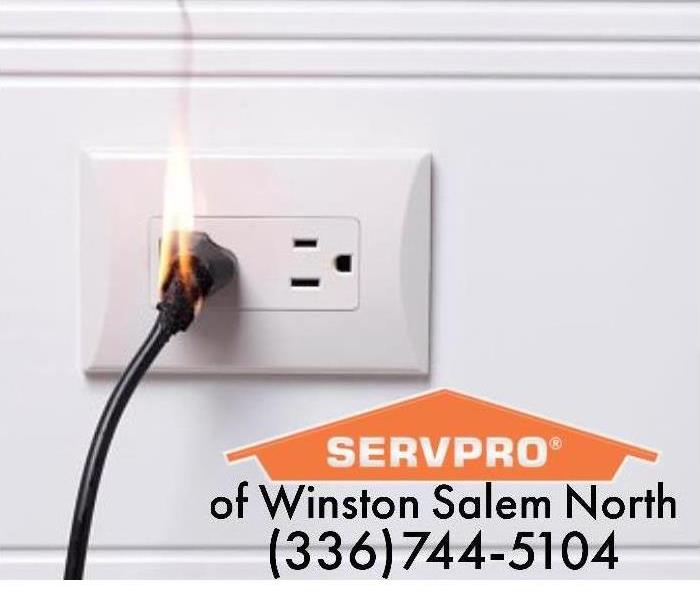 While we hope you never experience a disaster in your home or business, we do know we are ready to help you restore it in the event of one
While we hope you never experience a disaster in your home or business, we do know we are ready to help you restore it in the event of one
If a fire has occurred in your home or business you likely will notice soot throughout the entire property, not just in the area where the fire occurred. So how does this happen? How can you get rid of the soot? Keep reading to find out more information about how soot travels during a fire and what you can do about it.
What Is Soot?
Soot is a black powdery or flakey substance that is produced when organic matter burns incompletely. This means that when things burn, they don’t completely disappear, they leave behind particles known as soot. Because soot comes from the burning of many different materials, it can also contain things like acids, chemicals, metals, soils, and dust. These soot particles leave behind a mess and often a foul smell.
How Soot Travels
When there is a fire in your home, soot can easily travel throughout your whole home. The ultra-light particles can float through the air and reach surfaces throughout your whole home. If the air conditioning or heat is running soot can even enter your HVAC system which will disperse soot throughout your whole home. When this happens air ducts should be cleaned to eliminate the HVAC system further dispersing soot throughout your home.
Can Soot Damage My Home?
Because soot has acidic properties it can further damage your home and harm indoor air quality. Soot can continue to degrade the surfaces and air quality in your home if it is not cleaned immediately.
What If There Wasn’t A Fire?
If you notice soot in your home, but there was never a fire, you might be wondering where the soot came from. Even if there wasn’t a fire, things like fireplaces, furnaces, and excessive use of candles can cause soot building throughout your home.
Is Soot Dangerous
Soot inhalation can be dangerous which is why you should only enter your home after it has been deemed safe by the Charlotte Fire Department and a fire restoration company. Improperly cleaning soot can lead to excessive inhalation of soot, and soot can be left behind, causing health effects in the future.
How To Clean Soot
Cleaning soot can be difficult to remove from many surfaces as it is a sticky substance and can stain fabrics. Additionally, cleaning soot improperly can mean breathing in soot particles.
When cleaning soot, safety equipment is essential for reducing the danger of soot exposure. Specialized techniques such as air scrubbing may be necessary to reduce linger scents and restore air quality.
Using household cleaners to clean soot isn’t enough. Soot particles will leave behind a smell and stain surfaces when professional tools and cleaners are not used. Fire restoration experts will be able to save your personal belongings that can’t be cleaned with household products.
If your home has experienced a fire and is in need of restoration experts, be sure to call SERVPRO of Winston Salem North. Our expert technicians can make it "Like it never even happened."
Tips That Can Prevent Fire Damage In Your Home!
8/23/2021 (Permalink)
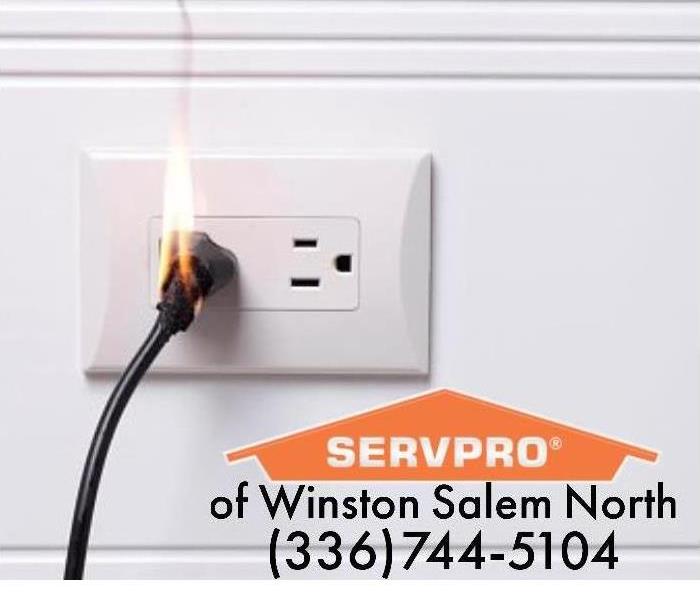 While we hope you never experience a disaster in your home, we do know we are ready to help you restore it in the event of one
While we hope you never experience a disaster in your home, we do know we are ready to help you restore it in the event of one
Nobody wants to think about the risk of a fire in their home. However, it is something you should think about and things you can do to help prevent it. We are going to discuss the prevention tips today.
- Practice basic fire prevention around the house.
~ Avoid smoking and leaving smoking materials laying around.
~Keep heating equipment clean and in repair.
~ Never leave candles unattended.
- Make sure your smoke detectors work. (test them twice a year)
- Know what flammable materials are and store them away from all heating equipment.
- Teach your kids fire safety.
~ Make sure your family knows what to do in the event of fire & have an evacuation plan.
- Be Prepared!
~ Keep important documents, photos, and valuables in a fireproof safe.
- Take extra precautions during the holidays when you are decorating to avoid fire hazards.
Be prepared and practice fire prevention tips to stay safe! SERVPRO of Winston Salem North wants you to know what you can do to stay safe. But we are always here for you in the event of a disaster.
Smoke Detectors
8/9/2021 (Permalink)
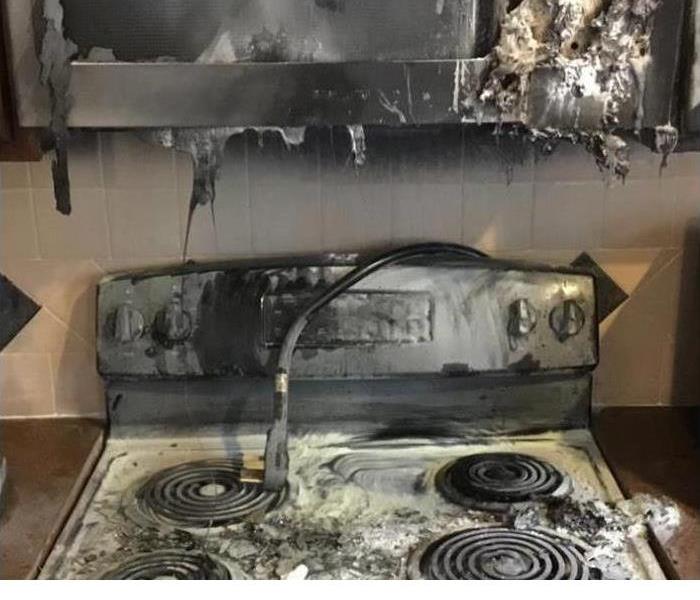 While we hope you never experience a disaster in your home, we do know we are ready to help you restore it in the event of one
While we hope you never experience a disaster in your home, we do know we are ready to help you restore it in the event of one
We have just started a new segment on our TikTok page called Tech Tuesday. We will go out to lunch every week and talk to a tech about simple things in a home that homeowners should know.
If you are a new homeowner or just moved out and are renting you may not know simple things that could be very helpful in your home. Our first topic this week was smoke detectors. You should be changing your smoke detector batteries twice a year. A good way to remember to change the batteries is to do it when the time changes. Hard wired smoke detectors also require batteries and you can write the date you changed the batteries on the smoke detector cover to help you remember. Smoke detectors should be replaced every ten years to make sure they are up to date. You should also be testing your smoke detectors about once a month to ensure that if something happens you are keeping yourself and your family safe. They have a test button on the alarm you can push to ensure they are working properly.
Even though SERVPRO of Winston Salem North is always here to help in the event something happens. We also want to educate our customers on what they should be doing in their homes to stay safe.
House Fires
7/6/2021 (Permalink)
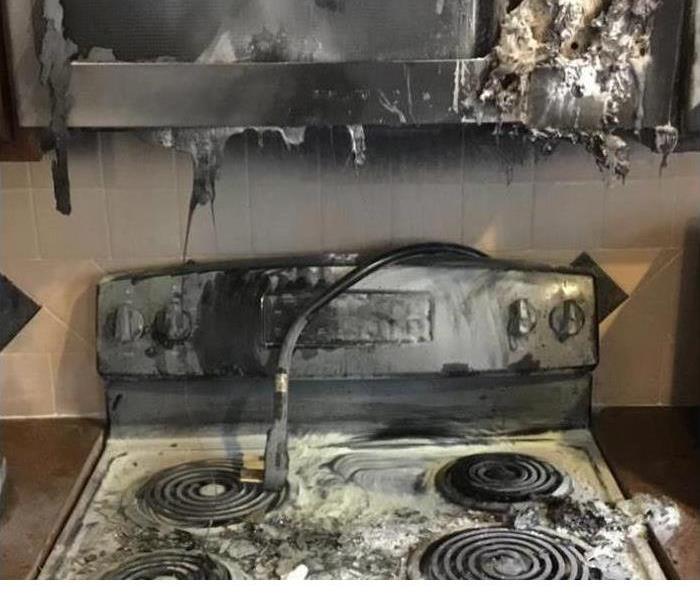 While we hope you never experience a disaster in your home, we do know we are ready to help you restore it in the event of one.
While we hope you never experience a disaster in your home, we do know we are ready to help you restore it in the event of one.
Our repair team has just finished a home that had a devastating amount of damage from a fire that started in the kitchen. The homeowner was there starting dinner and got distracted... it only took minutes until there were flames. I had gotten some before pictures where we could see the damage that the fire had caused. In the images, you could see the soot webs all over the ceilings and walls. This is where the soot particles bond together, clinging to walls and ceilings, creating webs resembling cobwebs. At first, our production team went to the home to do the demo and clean. Then our repair team was able to step in where they put in all new flooring, painted all the walls, and put in new appliances. After a big majority of the work was done it did not even look like the same home. We were so excited to begin allowing the homeowner to start moving back into her home that just had a complete makeover. She was ready and so were we! We were so appreciative of the homeowner for allowing us to do the work in her home like we are with all of our customers. We left her a boutique of flowers and a thank you card. We did that so she would understand how thankful we were and in hopes, if something else, unfortunately, happens she would know to call us or could refer us to someone she knows.
What you can do to get ready for Grilling Season!
6/1/2021 (Permalink)
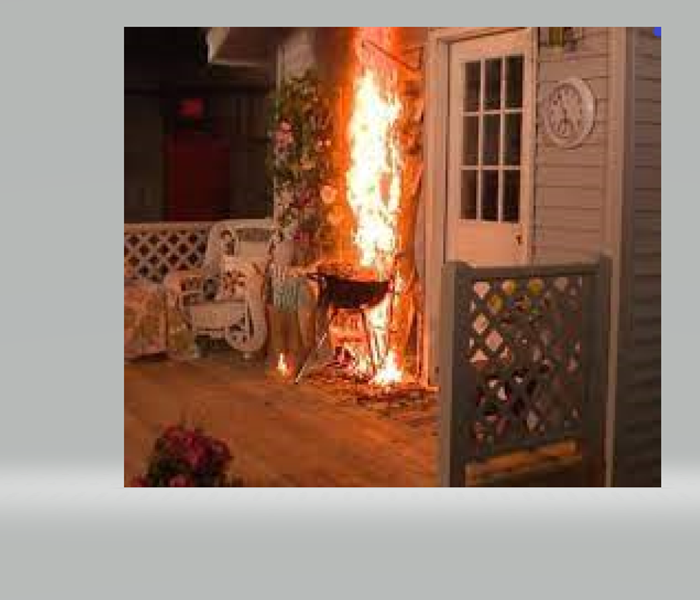 Nobody ever thinks this could happen to them. Be cautious and safe!
Nobody ever thinks this could happen to them. Be cautious and safe!
We hope everyone had a wonderful and safe Memorial Day!... But now it is time people are going to be bringing out their grills for the summer and we want you to be safe.
First thing when you bring out your grill you want to give it a basic scrub and wipe down. You do not want to place your grill near your home and you never want to grill in a garage or on your patio.
Be sure before firing your grill up, you check for any gas leaks, check all the connections and make sure it is all cleaned out. This link will give you some tips.
https://www.thebbqdepot.com/blog/get-your-grill-ready-for-summer/
While grilling make sure you always have an eye out. Often time fires are started from children and pets knocking the grill over.
Here at SERVPRO we never want anyone to go through any type of traumatic event but we know it happens. In the event something does happen we are HERE TO HELP and will do anything and everything we can to satisfy our customers.
What Kind of Smoke Detector Do I need?
9/3/2020 (Permalink)
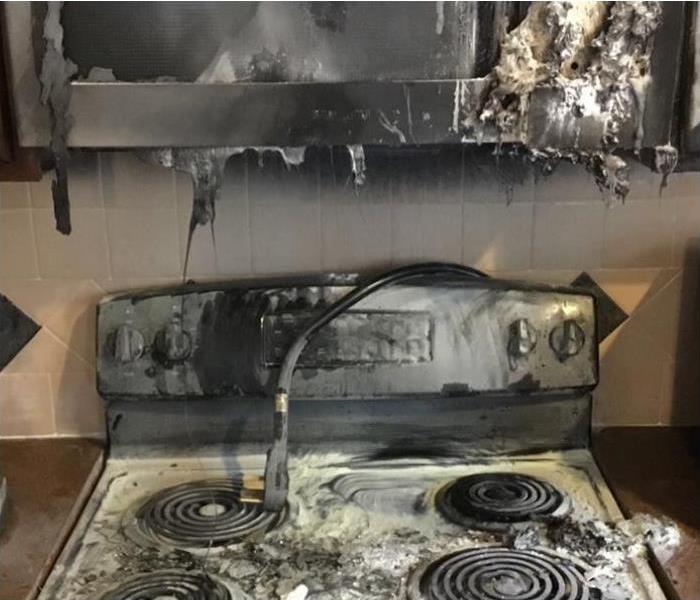 While we hope you never experience a disaster in your home, we do know we are ready to help you restore it in the event of one
While we hope you never experience a disaster in your home, we do know we are ready to help you restore it in the event of one
There are 3 types of smoke detector alarms on the market today. They are Ionization, Photoelectric and Combination.
An ionization smoke alarm contains a small amount of radioactive material. The radiation passes through an ionization chamber which is an air-filled space between two electrodes and permits a small, constant current between the electrodes.
When smoke that enters the chamber absorbs the alpha particles, it reduces the ionization and interrupts the current, setting off the alarm.
This type of alarm is generally more responsive to flaming fires.
The Photoelectric smoke alarms operate using a light source.
A light beam collimating system and a photoelectric sensor. When smoke enters the optical chamber and crosses the path of the light beam, some light is scattered by the smoke particles, directing it at the sensor and thus activating the alarm.
This type of alarm is generally more responsive to fires that begin with a long period of smoldering.
Combination smoke alarms feature both ionization and photoelectric technologies. Ionization smoke alarms respond faster to high energy fires, whereas photoelectric detectors respond better to low energy smoldering fires. The best overall protection is provided by using combination smoke alarms.
Outdoor Fire and Grill Tips
9/3/2020 (Permalink)
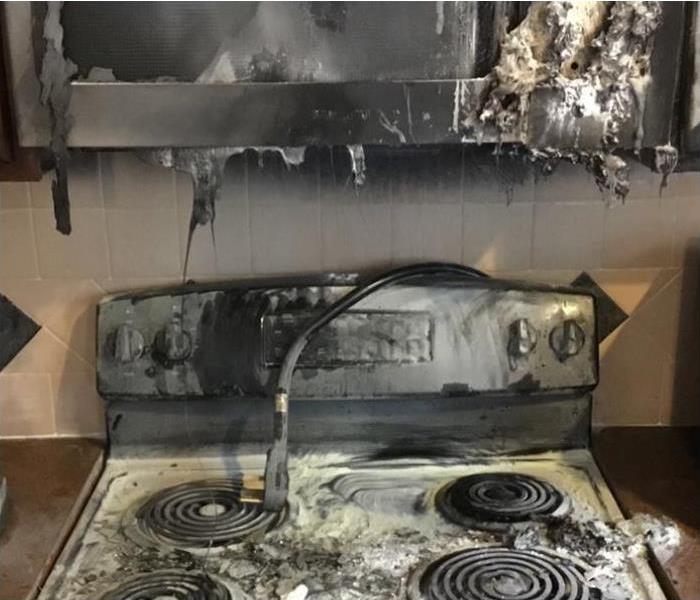 While we hope you never experience a disaster in your home, we do know we are ready to help you restore it in the event of one
While we hope you never experience a disaster in your home, we do know we are ready to help you restore it in the event of one
It’s GRILLING season. As everyone starts enjoying the weather, people use outdoor grills – and incidents of grill-caused fires go up. Outdoor grilling causes an annual average of 10,200 home fires, according to the National Fire Protection Association. That statistic goes up every single year!
Gas grills cause more home fires than charcoal grills. Gas grills cause more fires mainly because 64% of households own a gas grill, 44% own a charcoal grill and 9% own an electric grill.
Fires can spring up from any type of grill, so we’ve got a helpful tip list for you.
Always Use your Grill Outside
Charcoal and gas grills are designed for outdoor use only. Not only could a fire spring up in your home, avoid grilling in your garage, on your patio, or under anything that is flammable.
Maintain your grill
Making sure everything is secure and undamaged when you take your grill out of storage. Check for rust on the structure and make sure all nuts and bolts are tight. Gas grills should be checked for leaks by using the “Soapy Water” technique.
A really good deep cleaning of the grill to start off the season is advised, and after each use make sure to wipe down and remove any build up or grease.
WATCH your grill
Never ever leave your grill unattended
Be ready to put out the fire
It’s always advisable to have a fire extinguisher nearby, and baking soda on hand for a grease fire. A bucket of sand will also do well to quell any fire.
Get all Fired up over Fire Damage Terminology
9/3/2020 (Permalink)
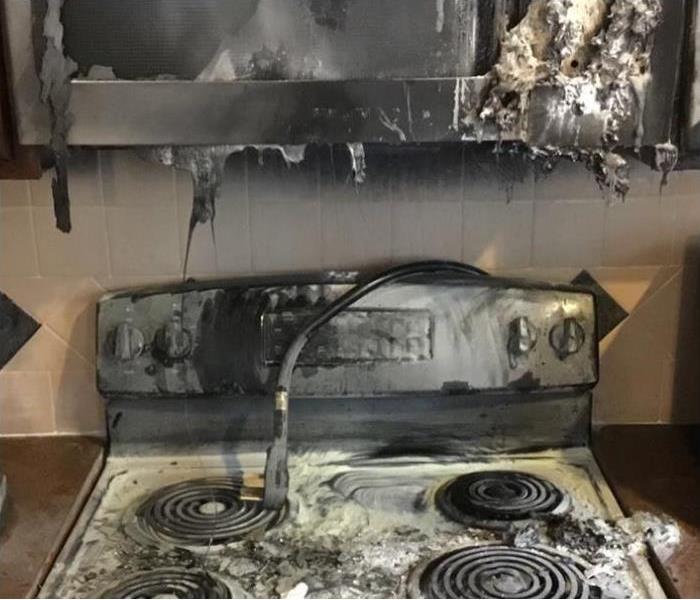 While we hope you never experience a disaster in your home, we do know we are ready to help you restore it in the event of one
While we hope you never experience a disaster in your home, we do know we are ready to help you restore it in the event of one
When a property experiences a fire, a homeowner or commercial property manager will begin to hear a lot of terms they aren't familiar with. Familiarizing yourself with this vocabulary will help facilitate your understanding of what is happening.
Rest assured that if you should ever need our help, our crew will walk you through the process of cleanup and restoration.
Fire Damage: This is a general term that says a fire was the cause of loss.
Stabilizing the Structure: This refers to the need to make a structure safe enough for our technicians to begin cleanup and remediation work. The fire must be completely put out. It may also include roof tarping, board-up, temporary fencing, and a security guard.
Roof Tarping: A thick, weatherproof piece of plastic tarping will be attached to the roof to prevent precipitation from entering the building and causing secondary damage.
Board-Up: When pieces of board are placed over damaged windows and doors to prevent precipitation from entering the building and also to deter possible break-ins.
Temporary Fencing: When a temporary fence is installed around the perimeter of the property or highly damaged areas to prevent possible break-ins and keep the general public away from sensitive areas.
Security Guard: When a structure cannot be immediately stabilized (for example, it’s raining and it’s not safe to tarp the roof), a 24-hour security guard can be hired to protect the property.
Secondary Damage: A damage that occurred which did not come from the original source. For example, in a fire damage, the fire is the primary damage. Secondary damage may come from the water used during firefighting efforts.
Pre-Loss Condition: Means to put the property back together the way it was before the fire damage. This is the goal of the insurance company when a fire damage occurs.
Smoke Damage: When smoke particles have embedded themselves in a material, like a wall, clothing, or piece of furniture. Smoke damage cannot usually be seen, but it can be smelled. Cleaning and deodorization should take place.
Soot Damage: When soot has sullied a material. Soot is produced by the incomplete burning during the fire. It is acidic and causes damage to materials when it’s not properly or promptly cleaned. Cleaning and deodorization should take place.
Demolition: When a material has experienced permanent damage and cannot be cleaned, it is removed and thrown away.
Containment: When thick plastic is set up in order to isolate the airspace of a room. This is done so that deodorization techniques can be more effective or to prevent an unaffected area of a property from becoming contaminated.
Air Scrubber: A machine that cleans the air.
HEPA Filter: High-Efficiency Particulate Arrestance filter can catch particles as small as 0.3 microns. This is our filter of choice when using an air scrubber.
Deodorization: When an item or property is rid of smells caused by the fire damage.
Structural Framing: The structure of the property, like beams. If the structure has been damaged, it must be replaced.
Contents: Anything that is not part of the structure, like furniture. When affected, contents can either be cleaned on-site or taken back to our cleaning facility.
Textiles: If you turned the property upside down and everything fell out, the items that fell and did not break are textiles. These include clothing, shoes, plush animals, etcetera. When affected, textiles are taken back to our facility for cleaning.
Pack-out / Pack-Back: When the structure isn’t safe, contents and textiles are moved out of the property and taken to our facilities for cleaning and storage. They are returned when the property is clean, reconstructed, and safe for inhabitants. Items may also be delivered to a second location if the owner would like them returned sooner.
Storage: Items that have been packed-out are stored in our facilities until they can be returned.
HVAC & Duct Work: Heating, Ventilation, and Air Condition system. Ducts are the pathways for the cold or warm air to travel around the property. Many times, the HVAC system needs to be cleaned after a fire damage because smoke has accumulated inside of it.
After A Fire Checklist
9/3/2020 (Permalink)
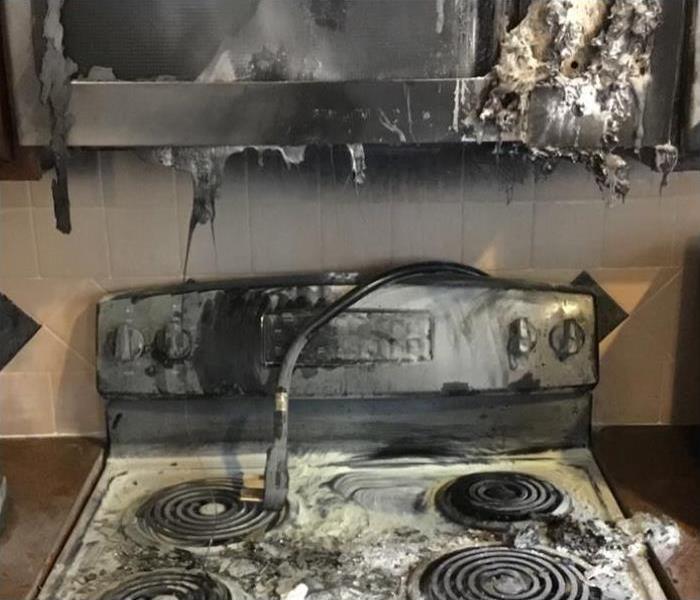 While we hope you never experience a disaster in your home, we do know we are ready to help you restore it in the event of one
While we hope you never experience a disaster in your home, we do know we are ready to help you restore it in the event of one
After a Fire
The following checklist serves as a quick reference and guide for you to follow after a fire strikes.
- Contact your local disaster relief service, such as The Red Cross, if you need temporary housing, food and medicines.
- If you are insured, contact your insurance company for detailed instructions on protecting the property, conducting inventory and contacting fire damage restoration companies. If you are not insured, try contacting private organizations for aid and assistance.
- Check with the fire department to make sure your residence is safe to enter. Be watchful of any structural damage caused by the fire.
- The fire department should see that utilities are either safe to use or are disconnected before they leave the site. DO NOT attempt to reconnect utilities yourself.
- Conduct an inventory of damaged property and items. Do not throw away any damaged goods until after an inventory is made.
- Try to locate valuable documents and records. Refer to information on contacts and the replacement process inside this brochure.
- Begin saving receipts for any money you spend related to fire loss. The receipts may be needed later by the insurance company and for verifying losses claimed on income tax.
- Notify your mortgage company of the fire.
During a Fire Checklist
9/3/2020 (Permalink)
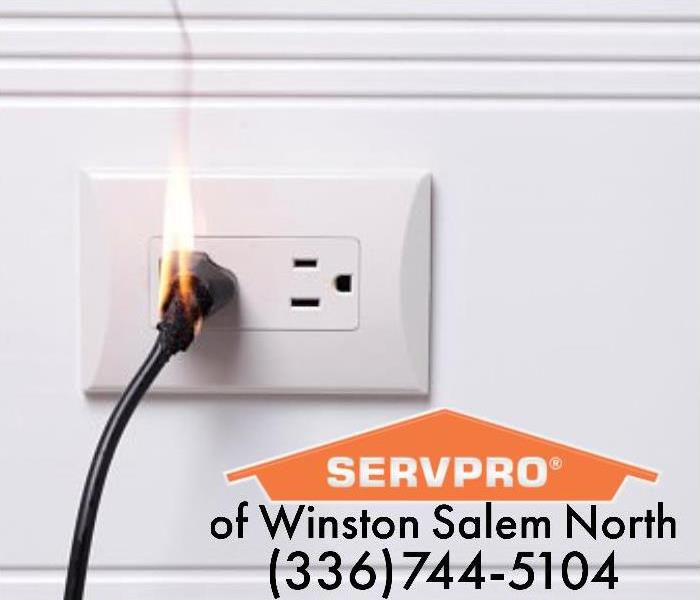 While we hope you never experience a disaster in your home, we do know we are ready to help you restore it in the event of one
While we hope you never experience a disaster in your home, we do know we are ready to help you restore it in the event of one
During a Fire
- Crawl low under any smoke to your exit - heavy smoke and poisonous gases collect first along the ceiling.
- Before opening a door, feel the doorknob and door. If either is hot, or if there is smoke coming around the door, leave the door closed and use your second way out.
- If you open a door, open it slowly. Be ready to shut it quickly if heavy smoke or fire is present.
- If you can’t get to someone needing assistance, leave the home and call 9-1-1 or the fire department. Tell the emergency operator where the person is located.
- If pets are trapped inside your home, tell firefighters right away.
- If you can’t get out, close the door and cover vents and cracks around doors with cloth or tape to keep smoke out. Call 9-1-1 or your fire department. Say where you are and signal for help at the window with a light-colored cloth or a flashlight.
- If your clothes catch fire, stop, drop, and roll – stop immediately, drop to the ground, and cover your face with your hands. Roll over and over or back and forth until the fire is out. If you or someone else cannot stop, drop, and roll, smother the flames with a blanket or towel. Use cool water to treat the burn immediately for 3 to 5 minutes. Cover with a clean, dry cloth. Get medical help right away by calling 9-1-1 or the fire department.
Fire Escape Planning for Older Adults and People with Access or Functional Needs
- Live near an exit. You'll be safest on the ground floor if you live in an apartment building. If you live in a multi-story home, arrange to sleep on the ground floor, and near an exit.
- If you use a walker or wheelchair, check all exits to be sure you get through the doorways.
- Make any necessary accommodations, such as providing exit ramps and widening doorways, to facilitate an emergency escape.
- Speak to your family members, building manager, or neighbors about your fire safety plan and practice it with them.
- Contact your local fire department's non-emergency line and explain your special needs. Ask emergency providers to keep your special needs information on file.
- Keep a phone near your bed and be ready to call 911 or your local emergency number if a fire occurs.
Before a Fire; House Fire 101
9/3/2020 (Permalink)
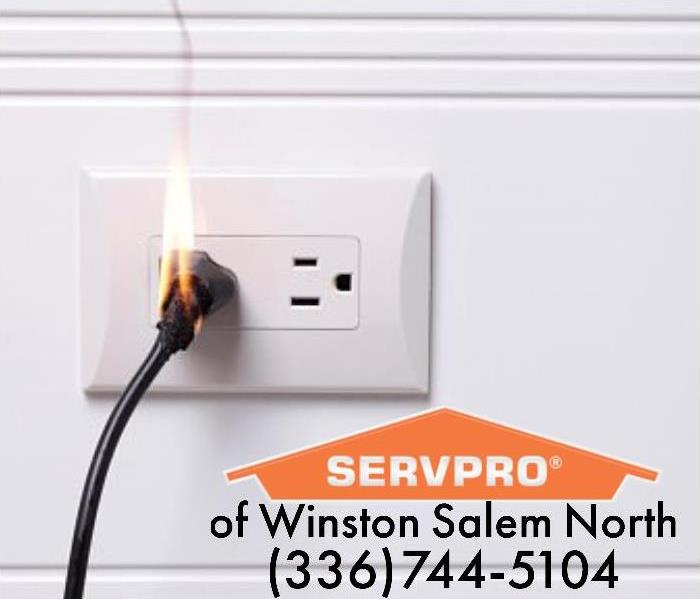 While we hope you never experience a disaster in your home, we do know we are ready to help you restore it in the event of one
While we hope you never experience a disaster in your home, we do know we are ready to help you restore it in the event of one
In just two minutes, a fire can become life-threatening. In five minutes, a residence can be engulfed in flames.
Learn About Fires
- Fire is FAST! In less than 30 seconds a small flame can turn into a major fire. It only takes minutes for thick black smoke to fill a house or for it to be engulfed in flames.
- Fire is HOT! Heat is more threatening than flames. Room temperatures in a fire can be 100 degrees at floor level and rise to 600 degrees at eye level. Inhaling this super-hot air will scorch your lungs and melt clothes to your skin.
- Fire is DARK! Fire starts bright, but quickly produces black smoke and complete darkness.
- Fire is DEADLY! Smoke and toxic gases kill more people than flames do. Fire produces poisonous gases that make you disoriented and drowsy. Asphyxiation is the leading cause of fire deaths, exceeding burns by a three-to-one ratio.
Before a Fire
Create and Practice a Fire Escape Plan
In the event of a fire, remember that every second counts, so you and your family must always be prepared. Escape plans help you get out of your home quickly.
Twice each year, practice your home fire escape plan. Some tips to consider when preparing this plan include:
- Find two ways to get out of each room in the event the primary way is blocked by fire or smoke.
- A secondary route might be a window onto a neighboring roof or a collapsible ladder for escape from upper story windows.
- Make sure that windows are not stuck, screens can be taken out quickly, and that security bars can be properly opened.
- Practice feeling your way out of the house in the dark or with your eyes closed.
- Teach children not to hide from firefighters.
Smoke Alarms
A working smoke alarm significantly increases your chances of surviving a deadly home fire.
- Install both ionization AND photoelectric smoke alarms, OR dual sensor smoke alarms, which contain both ionization and photoelectric smoke sensors.
- Test batteries monthly.
- Replace batteries in battery-powered and hard-wired smoke alarms at least once a year (except non-replaceable 10-year lithium batteries).
- Install smoke alarms on every level of your home, including the basement, both inside and outside of sleeping areas.
- Replace the entire smoke alarm unit every 8-10 years or according to manufacturer’s instructions.
- Never disable a smoke alarm while cooking – it can be a deadly mistake.
Smoke Alarm Safety for People with Access or Functional Needs
- Audible alarms for visually impaired people should pause with a small window of silence between each successive cycle so that they can listen to instructions or voices of others.
- Smoke alarms with a vibrating pad or flashing light are available for the hearing impaired. Contact your local fire department for information about obtaining a flashing or vibrating smoke alarm.
- Smoke alarms with a strobe light outside the home to catch the attention of neighbors, and emergency call systems for summoning help, are also available.
More Fire Safety Tips
- Make digital copies of valuable documents and records like birth certificates.
- Sleep with your door closed.
- Contact your local fire department for information on training on the proper use and maintenance of fire extinguishers.
- Consider installing an automatic fire sprinkler system in your residence.
Fast Home Fire Facts
9/3/2020 (Permalink)
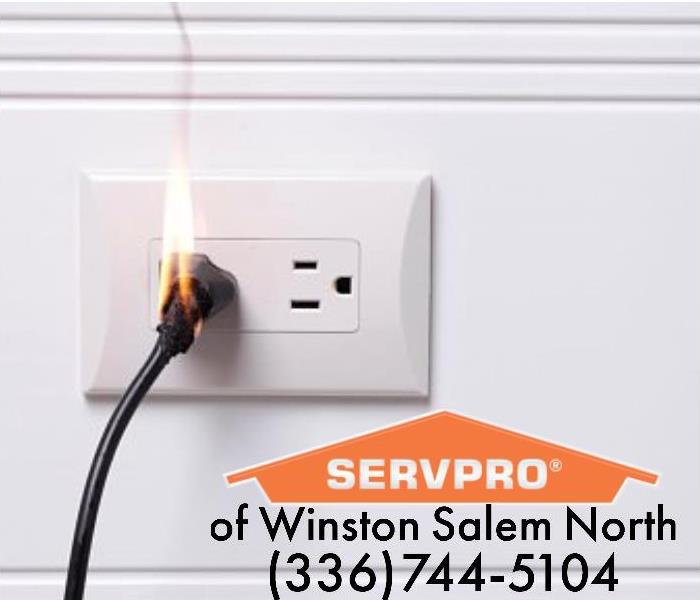 While we hope you never experience a disaster in your home, we do know we are ready to help you restore it in the event of one
While we hope you never experience a disaster in your home, we do know we are ready to help you restore it in the event of one
Prevent Home Fires
Home fires are preventable! The following are simple steps that each of us can take to prevent a tragedy.
Cooking
- Stay in the kitchen when you are frying, grilling, or broiling food. If you leave the kitchen for even a short period of time, turn off the stove.
- Wear short, close-fitting or tightly rolled sleeves when cooking.
- Keep children away from cooking areas by enforcing a "kid-free zone" of 3 feet around the stove.
- Position barbecue grills at least 10 feet away from siding and deck railings, and out from under eaves and overhanging branches.
Smoking
- Smoke outside and completely stub out butts in an ashtray or a can filled with sand.
- Soak cigarette butts and ashes in water before throwing them away. Never toss hot cigarette butts or ashes in the trash can.
- Never smoke in a home where oxygen is used, even if it is turned off. Oxygen can be explosive and makes fire burn hotter and faster.
- Be alert - don’t smoke in bed! If you are sleepy, have been drinking, or have taken medicine that makes you drowsy, put your cigarette out first.
Electrical and Appliance Safety
- Frayed wires can cause fires. Replace all worn, old or damaged appliance cords immediately and do not run cords under rugs or furniture.
- If an appliance has a three-prong plug, use it only in a three-slot outlet. Never force it to fit into a two-slot outlet or extension cord.
- Immediately shut off, then professionally replace, light switches that are hot to the touch and lights that flicker.
Portable Space Heaters
- Keep combustible objects at least three feet away from portable heating devices.
- Buy only heaters evaluated by a nationally recognized laboratory, such as Underwriters Laboratories (UL).
- Check to make the portable heater has a thermostat control mechanism, and will switch off automatically if the heater falls over.
- Only use crystal clear K-1 kerosene in kerosene heaters. Never overfill it. Use the heater in a well-ventilated room.
Fireplaces and Woodstoves
- Inspect and clean woodstove pipes and chimneys annually and check monthly for damage or obstructions.
- Use a fireplace screen heavy enough to stop rolling logs and big enough to cover the entire opening of the fireplace to catch flying sparks.
- Make sure the fire is completely out before leaving the house or going to bed.
Children
- Take the mystery out of fire play by teaching children that fire is a tool, not a toy.
- Store matches and lighters out of children's reach and sight, preferably in a locked cabinet.
- Never leave children unattended near operating stoves or burning candles, even for a short time.
More Prevention Tips
- Never use a stove range or oven to heat your home.
- Keep combustible and flammable liquids away from heat sources.
- Portable generators should NEVER be used indoors and should only be refueled outdoors or in well ventilated areas.
What can I keep after a house fire?
9/3/2020 (Permalink)
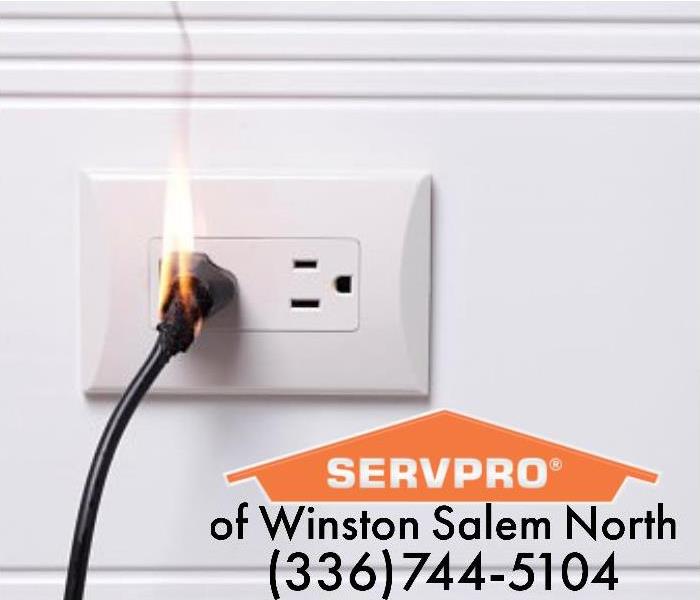 While we hope you never experience a disaster in your home, we do know we are ready to help you restore it in the event of one
While we hope you never experience a disaster in your home, we do know we are ready to help you restore it in the event of one
In 2017, The Fire Department of Winston-Salem responded to over 700 house fires. Statistically that's 2 or more fires a day. Our Brave Men and Women at the WSFD, are tasked with a grueling and unforgiving job. Time and again, they are called upon day after day to run head first into burning buildings and cars to save those inside.
Next Monday, October 28th 2019 is National First Responders day, and I hope everyone finds a time to thank our local Winston-Salem First Responders.
Did you know, that after a fire, most items in your home are potentially dangerous? There are 4 things that you need to throw away immediately after a fire.
- Perishable Food items
- These items were exposed to extreme temperatures and will spoil quickly. Power is generally cut and those food items in your fridge will have reached unsafe temps for too long.
- Non Perishable Food Items
- Everything in cupboards and on counters were exposed to fire, soot, and possible fire extinguishing chemicals and are now unsafe to eat.
- Cosmetics and Medicines
- After being exposed to high heat, most cosmetics and medicines have melted. Even more importantly, medicines exposed to high heat might have changed chemically and are no longer safe to ingest, or have become obsolete.
- Clothing, Bedding, and soft textiles
- If it was burned or singed in any way, properly dispose of them.
- Find a professional cleaning service, and they might be able to salvage and clean some items.
Time to get your Fireplace ready!
9/3/2020 (Permalink)
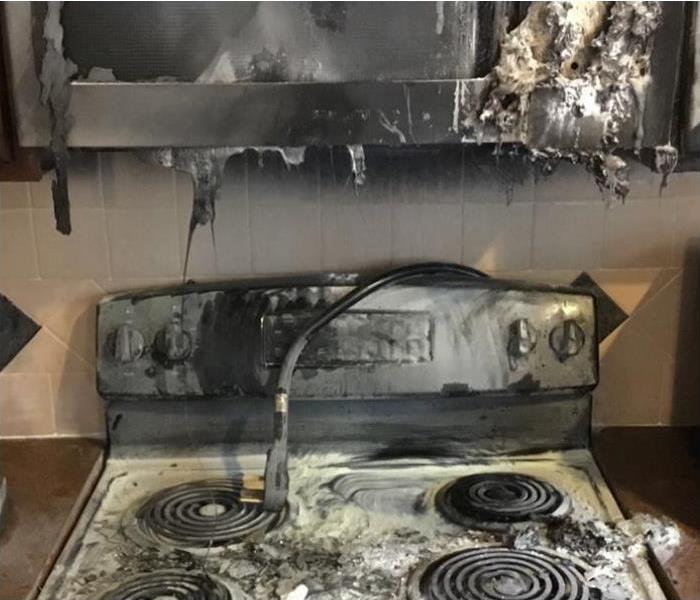 While we hope you never experience a disaster in your home, we do know we are ready to help you restore it in the event of one
While we hope you never experience a disaster in your home, we do know we are ready to help you restore it in the event of one
It’s finally Autumn! My very favorite time in the whole year. It means the weather is at its peak perfect temperature. I’ve never been a Winter snow bunny, and although I did lifeguard all summer, I’m not a huge fan of cooking outside. Fall is just the very best! The mornings are cool and crisp, perfect for warm coffee and breakfast. The days are warm enough to enjoy being outside and not overly humid or stuffy. The evenings cool down and are just perfect to enjoy a nice bonfire or maybe a fire in the fireplace.
Fireplaces can be both wonderful and amazing, but they can get dangerous if not properly maintained.
How to get your chimney ready for Fall
- Sweep the Chimney
- Check your Chimney Cap
- A chimney cap is a covering for the top of your chimney, checking it is pretty simple.
- Top is in place
- Wire is free of debris
- No holes made by animals or storm debris
- Check your Fire Alarms
- A yearly battery change in all smoke and co2 alarms is a smart habit to start, and it is recommended by the North Carolina State Firefighters Association to replace your fire alarm system every 10 years.
- Safety.com : Best Smoke Detectors for 2019
- If you have a hardwired smoke alarm system, make sure it is connected and active with your home alarm system.
Quickly and Safely Fire suppression 101
9/3/2020 (Permalink)
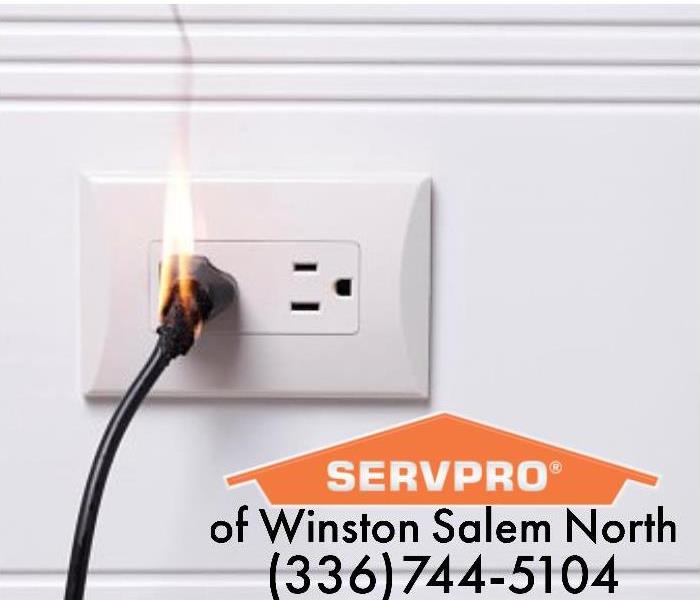 While we hope you never experience a disaster in your home, we do know we are ready to help you restore it in the event of one
While we hope you never experience a disaster in your home, we do know we are ready to help you restore it in the event of one
Did you know there were 4 Different types of fires?
These are the easiest to put out, and the best way to put them out is using water, ex. a water hose or a bucket full of water. A foam fire extinguisher would also be a great option on Class A fires.
- Class B
- Flammable Liquids
- oil
- alcohol
- gasoline
- grease (cooking grease)
NEVER EVER use WATER on a Class B fire. This will cause the flaming material to scatter rather than extinguish it. The best course of action is using a powder like baking soda, or a carbon dioxide extinguisher. A foam fire extinguisher would also work.
- Class C
- Electrical
- old wiring
- fault equipment
- bad/damaged wiring
First, shut off power to the electrical fire. That could be as easy as shutting off a breaker, or unplugging the appliance. Then use a carbon dioxide or dry powder to extinguish the flames if they remain or if any appeared.
- Class D (uncommon)
- metal ignition
- mainly in laboratories or industrial type buildings
The best course of action is to use a fire extinguisher if the fire is small enough, otherwise call 911 and evacuate the area.
There are Different Types of Soot
9/3/2020 (Permalink)
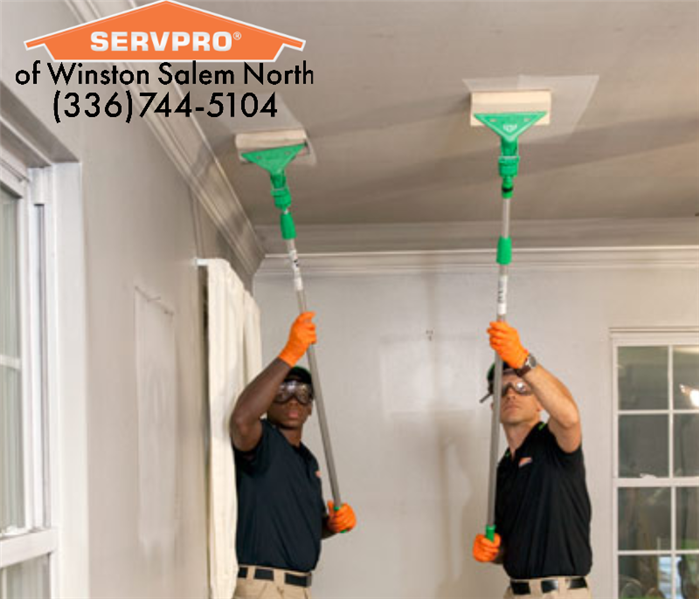 While we hope you never experience a disaster in your home, we do know we are ready to help you restore it in the event of one
While we hope you never experience a disaster in your home, we do know we are ready to help you restore it in the event of one
This past week, I got some more field experience in fire and soot damage. I had no idea there were different kinds of soot, and different ways of optimal removal. Each job is unique and offers its own challenges, but we can broadly classify soot in a few categories.
- Wet/Oil Soot
When Plastics, rubber or oil is burned, leaving behind a sticky and smeary residue. It has a distinct electrical burnt smell. Also the most dangerous to inhale and clean up, as it is full of toxins from the plastic, rubber or oil that burned. - Dry Soot
Usually from natural materials, ex. Untreated wood, Plant material, Paper, Lint, cotton/textile clothing. Most of these burn very fast and very hot, quickly escalating across the area, and consuming everything in its path. - Fuel Oil Soot
Commonly found in oil furnaces, Caused by improperly maintained systems, or damaged parts. This will cause an internal combustion, damaging the machine and possibly spreading to the area around it.
- Protein Soot
Typically food or kitchen type fires, with long lasting smells, ex. burnt popcorn. This type of soot is very light, but will build up over time, and leave a slightly stick surface on walls and ceilings. Will eventually discolor everything. This requires a great deal of time and effort to clean up, with a long deodorization method used.






 24/7 Emergency Service
24/7 Emergency Service

























